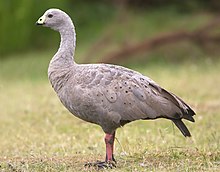Wp/nys/Kaangan - Gaangan (Cape Barren Goose)



Kaangan (Noongar LOTE)[1] or Gaangan (Kongal-boyal)[1] is a large goose resident in southern Australia. It is called in English the Cape Barren Goose and its scientific name is Cereopsis novaehollandiae. The English name comes from Cape Barren Island (Aboriginal name: Truwana, an island off the north east coast of Tasmania)[2], where specimens were first sighted by European explorers.
The population in Western Australia is a distinct sub species Cereopsis novaehollandiae grisea called Recherche Cape Barren goose or Cape Barren goose (southwestern) in English. Its only breeding site is the Recherche Archipelago, locally known as the Bay of Isles, which stretches from Esperance to Israelite Bay. The conservation status of this WA population is Vulnerable, whilst the main population's status is Least Concern.
The short, decurved black bill and green cere (the soft, fleshy, patch on the beak, see close up picture) gives it a very peculiar expression. Their ability to drink salt or brackish water allows numbers of geese to remain on offshore islands all year round.[3] They are one of the rarest of the world's geese.[3] They are gregarious outside the breeding season, when they wander more widely, forming small flocks.
Its place in the scientific tree of birds is uncertain, it could be in a distinct subfamily Cereopsinae, on its own or possibly including the extinct flightless New Zealand goose. The first bones of the New Zealand birds to be discovered were similar enough to those of the Cape Barren goose to erroneously refer to them as the "New Zealand Cape Barren goose".
Kaangan Waarnk - Stories about the Cape Barren Goose[edit | edit source]
Ngiyan waarnk - References[edit | edit source]
- ↑ 1.0 1.1 "Djerap - Noongar Birds". Batchelor Press. 2014. ISBN 978 1 74131 292 8
- ↑ Island's name is now Truwana
- ↑ 3.0 3.1 "Cape Barren Goose, Cereopsis novaehollandiae". Parks & Wildlife Service. Retrieved 1 April 2018
